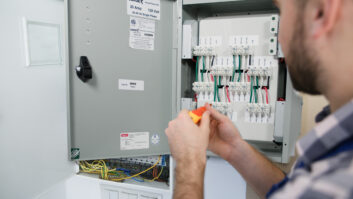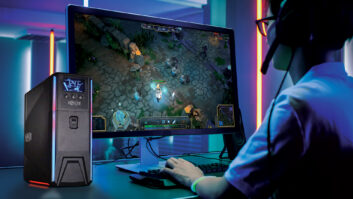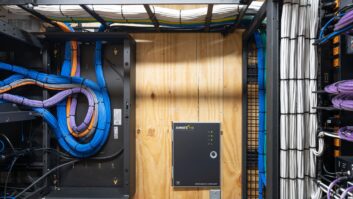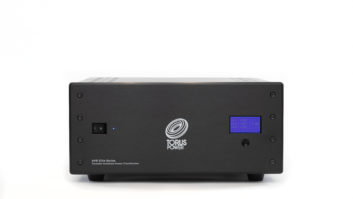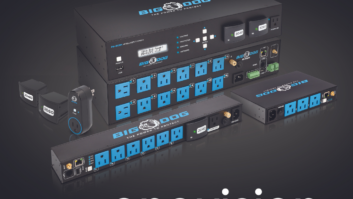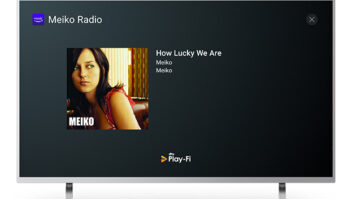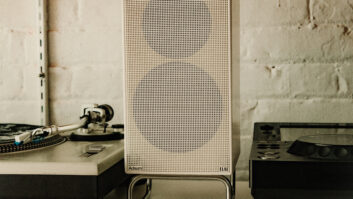Sonance Architectural SeriesThis Integration Guide to Designer-Friendly Speakers was sponsored by Lowell and PSB Speakers as a supplement to Residential Systems, February 2014.

Sonance’s Architectural Series provides a totally flush and bezel-less aesthetic that eliminates unsightly shadows and complements trim-less light fixtures.
The relationship between interior designers and custom integrators has been one of cautious collaboration. Playing by different rule books governed by the same goal of pleasing the client, the interior designer’s vision of sleek, clean lines is sometimes interrupted by the custom integrator’s more bluntly defined desire to deliver an entertainment system that can potentially blow the roof off of the house, sleek lines or not. This design skirmish has most often been incited by loudspeakers, which in their more familiar boxy, bulky (and, arguably, more audiophile friendly) form are an eyesore for many interior designers.
“Designers are essentially artists, not technologists, and tech stuff scares the heck out of them, making them defensive toward what integrators have to do to build great systems,” said Steve Olszewski, vice president of Stealth Acoustics. “In the end, the goal is to not compromise on either the aesthetics or proper system performance through thoughtful communication.”
In recent years, the advent of in-wall, in-ceiling, soundbar, and slimly designed speakers for custom integration projects has done wonders in tempering the relationship between designers and integrators. Adhering to the now common minimalistic aesthetics of most high-end homes, designer-friendly custom-grade loudspeakers are a welcome option for homeowners, while manufacturers continue to creatively match attractive form with quality sonic function.
Hiding in Plain Sight
When it comes to fulfilling an audio integration brief that is laden with concealed sightline demands, CI professionals are spoiled for choice. As an outgrowth of working with interior designers and home décor conscious clients, nearly every loudspeaker manufacturer that caters to our channel now has a speaker series to accommodate requests for in-ceiling and in-wall speakers.

Lowell’s new ES series of recessed in-ceiling speakers feature two models: the 6.5-inch ES-62T and the 4-inch dual-core ES-4T. Designed with system integrators in mind, the ES series come equipped with mounting hardware, built-in reversible mounting dogs for ease of installation, and can be mounted in drywall, wood, and tile. “Sonance invented the architectural speaker category 30 years ago to fulfill a need for a loudspeaker that delivered excellent sonic performance without compromising the aesthetic of a space,” said Chris Easter, Sonance’s product manager. “Technology has come a long way since then, however the principals remain the same. There are many things that can be done to minimize visual intrusion; from the industrial design, to the way the product is installed.”
Sonance’s Visual Performance Series, regarded as the company’s go-to speaker for traditional custom integration projects, offers a low-profile solution that can be painted to match wall or ceiling colors, while its broad range of shapes, sizes, performance levels and specialty application speakers (there are more than 50 models in the line) allows designers and integrators to maintain a consistent aesthetic across several rooms.
Core Brands, parent company to several custom integration speaker manufacturers including SpeakerCraft and Niles Audio, has an extensive line of in-wall and inceiling options that covers just about every residential loudspeaker request. Among those solutions is SpeakerCraft’s popular in-wall AIM Cinema Five, which Mitch Witten, director, Audio Segment at Core Brands, noted is “the equal of any high-end audiophile or home theater speaker out there today.”
Witten continued: “It’s got dual 6-inch Kevlar woofers, dual 5.25- inch Kevlar midranges and a 1-inch aluminum dome tweeter—the same kind of driver complement you’d find in some of the very top audiophile speakers on the market.”
The AIM Cinema Five is complemented by its in-ceiling counterpart, the AIM 7 Five LCR home theater speaker.

The “end of aesthetic pollution” could be a mission statement for Stealth Acoustics, whose new LineaResponse G Series adheres to the company’s philosophy to “offer great invisible speakers that perform as well or better than traditional visible speakers and then get out of the way of the array of things you see in homes.” The “end of aesthetic pollution” could be a mission statement for Stealth Acoustics, whose new LineaResponse G Series adheres to the company’s philosophy as noted by Olszewski to “offer great invisible speakers that perform as well or better than traditional visible speakers and then get out of the way of the array of things you see in homes.”
The LineaResponse G series of invisible speakers and subwoofers includes seven models that feature the company’s Fidelity Glass face panel material to deliver depth of sound, while a grille-less form factor makes them truly invisible.
“An integrator can chose a Stealth speaker from very cost effective to audiophile-grade, including high-output and completely invisible subwoofer solutions,” Olszewski said. “This approach is just like what is available with visible speakers. All of our speakers install simply to standard construction framing and are finished in the same manner as any typical wall or ceiling, including the paint, wallpaper, or other applications typically used. The practices used to install a hidden speaker are very familiar to designers and builders and that connection helps bridge the gap between the designers’ eyes and the listeners’ ears.”

Bay Audio’s Live-Wall is an invisible speaker solution that turns a wall’s surface into a speaker diaphragm. The line, which also includes an invisible subwoofer, has the LW1218 as its primary speaker.
TruAudio made an impact on the CI loudspeaker channel years ago with its Ghost Series, a frameless in-ceiling speaker with a mere two-millimeter reveal that virtually disappears into the décor when colored matched. Inspired by an interior designer’s request, the company, in recent years, has expanded the series with its Ghost 4-inch in-ceiling speaker.

SpeakerCraft’s in-wall AIM Cinema Five, is what Mitch Witten, director, Core Brands’ Audio Segment at Core Brands, says is “the equal of any high-end audiophile or home theater speaker out there today.” “We were approached by an interior designer who said that she loved the Ghost speakers, but wanted to know if we could design one that would match the size of recessed can lighting,” recalled Kary Wawrzyniak, vice president of TruAudio’s technical development. “In essence, she wanted us to take the Ghost a step further and develop one that would match perfectly the other design elements in the ceiling. From that request, we created the Ghost 4-inch in-ceiling speaker that matches the footprint of standard can lighting. The Ghost 4-inch truly speaks to an interior designer in both matching and minimalism.”
Last year, Meridian launched its latest range of in-wall speakers, the DSP520 and DSP640, both of which feature paintable magnetic grills, flexible back box adjustments for various wall materials and depths, and engineering derived from the company’s floorstanding DSP7200 Digital Active loudspeaker.
“Our design targets for these were to make the products as easy to fit, as small, as adaptable and as inconspicuous as possible but to retain performance levels unmatched by passive designs,” said Allen Boothroyd, co-founder and design director at Meridian Audio. “The results are excellent and a true testament to our unique DSP technology allowing designers more flexibility to position speakers neatly yet provide sound quality as good and better than freestanding products.”
Canadian loudspeaker manufacturer Bryston also has taken elements of one of its popular floorstanding speaker models, the Model T and Model A series, and translated them into the TIW and TOW architectural speakers, which are ideal for home theater systems.
“Accommodating aesthetics interferes with the sonic performance of a loudspeaker, so at Bryston, we have created a speaker with wide dispersion characteristics by bringing the drivers as far forward in the assembly as possible,” said James Tanner, the company’s vice president of sales and marketing, of the flagship models that launched at last year’s CEDIA EXPO. “By recessing the drivers even slightly, dispersion is narrowed dramatically—think of the narrow beam of a flashlight versus the wide dispersion of a floodlight—and sound quality suffers. Bryston offers a coaxial solution for ceiling applications, and both two-way and three-way in-wall and on-wall speakers. All are paintable to match any décor. The flagships in our lineup are the TIW [with an] in-wall three-way sealed enclosure, and the TOW [with an] on-wall three-way bottom-ported enclosure.”
Bay Audio’s Live-Wall is an invisible speaker solution that turns a wall’s surface into a speaker diaphragm. The line, which also includes an invisible subwoofer, has the LW1218 as its primary speaker. Less than 3 inches deep and weighing less than eight pounds, the LW1218 features a 12 x 18 diaphragm of woven fiber-glass that vibrates imperceptibly behind a variety of surfaces, including drywall mud, plaster, paint, wall paper, and light stucco textures.

Artison’s LCR DM Mark II and Studio series are visible speaker solutions that blend in with the prescribed electronic environment without impacting designer sensibilities. The former, which comes in three models (Masterpiece, Portrait, and Sketch) that attach directly to flat-panel televisions or can be wall mounted, combines three front-channel speakers (left, right, center) in two slim enclosures, while the Studio SoundBar Series also comes in three models.
“Competitive invisible loudspeaker solutions may have satisfied the requirements of the designer, but once the designer’s job was done, the homeowner suddenly realized that their music playback quality was awful,” noted Ira Friedman, CEO of Bay Audio. “Live-Wall maintains the integrity of the décor while satisfying the desire of the homeowner to enjoy quality sound.”
With its goal to deliver “stunning sound quality” with minimal impact on a room’s décor, Crestron points to its Essence and Aspire range of speakers that feature paintable zero-bezel grilles, enabling designers to match the speaker to the space. Of note is the Essence 6.5-inch, 150W two-way in-ceiling speaker, which features 6.5-inch long throw woven Kevlar woofers and large, 1.1-inch synthetic polymer dome tweeters.
“Aspire offers an in-wall subwoofer with the same paintable zero-bezel grille, which enables discreet low-end,” said Tom Barnett, Crestron’s residential marketing director. “Essence ceiling speakers include both round and square grilles to enable matching the designer’s preference.”
SolidDrive, a speaker manufacturer that falls under the MSE Audio umbrella, has developed a series of namesake speakers that work by inducing sound waves in the surface to which they are mounted, effectively turning the entire surface into a speaker. The line includes the SD1 for in-wall and in-ceiling surfaces, the SD1g for mounting under glass and other smooth surfaces, the SD1sm for mounting onto wood and other porous surfaces and the SD1 Desktop Kit 250 for use on top of horizontal surfaces.

Canadian loudspeaker manufacturer Bryston also has taken elements of one of its popular floorstanding speaker models, the Model T and Model A series, and translated them into the TIW and TOW architectural speakers, which are ideal for home theater systems. “The only visible SolidDrive units are those installed on windows and other clear surfaces, and even those can be placed in an unobtrusive location on the surface so as to not interrupt the look of the room,” noted Jonathan Duran, regional sales manager for MSE Audio. “SolidDrive units can be installed behind a wall or mirror, on a window, underneath tables, inside cabinets, in the ceiling, even under flooring.”
Lowell’s new ES series of recessed in-ceiling speakers feature two models: the 6.5-inch ES-62T and the 4-inch dual-core ES-4T. Designed with system integrators in mind, the ES series come equipped with mounting hardware, built-in reversible mounting dogs for ease of installation, and can be mounted in drywall, wood, and tile.
“Lowell’s new ‘ES Series’ is especially suited for designer-driven, residential installs,” noted Tom Lowell, residential sales manager for the company. “Not only does the ceiling grille blend with home decor but the compact design is available in several configurations to accommodate a variety of specifications and space limitations.”
Befitting the Décor
Although in-wall/in-ceiling speakers are the go-to solutions for designer-driven spaces, visible alternatives such as soundbars and elegantly crafted floorstanding speakers are still options that both designers and integrators can agree on.
In addition to its Invisa in-wall and in-ceiling speakers, GoldenEar Technology has had success with its SuperCinema 3D Array Soundbars, which Jack Shafton, vice president of sales and marketing, said allows integrators to sell complete installation packages.

PSB’s Imagine W-LCR2 in-wall speakers offer frameless grilles with fabric scrim.
“The aesthetic appeal of the soundbar is undeniable,” Shafton said. “Correctly sized, shaped, and finished, like the GoldenEar 3D Array products, they are able to blend in with the TV and add nothing to the designer’s environment—the holy grail of integration. Problem is that specialty AV dealers and integrators selling performance and installation/setup can’t be selling low-end (or even high-end) plug-and-play solutions that don’t sound good. The 3D Array soundbars are passive, meaning the integrator needs to sell electronics, installation, and setup, along with lighting control, drapes, control systems, etc.—all the things a specialty AV integrator does.”
Artison’s LCR DM Mark II and Studio series are visible speaker solutions that blend in with the prescribed electronic environment without impacting designer sensibilities. The former, which comes in three models (Masterpiece, Portrait, and Sketch) that attach directly to flat-panel televisions or can be wall mounted, combine three front-channel speakers (left, right, center) in two slim enclosures utilizing Artison’s patented DualMono center channel technology, while the Studio SoundBar Series also comes in three models (55, 46, 39), which feature proprietary extruded aluminum enclosures that are 2.2-inches deep and woven carbon fiber woofers.
“A speaker that has incredible sonic performance is a not an option if the consumer or the interior designer refuses to allow them to live in the home,” noted Dave Donald, vice president of sales and marketing for Artison. “While we pride ourselves in incredible sound quality, we are equally proud of our efforts to design speakers that either blend into the walls or attach to a television and hide in plain sight.”
Focusing on speakers as their own kind of sculptural art, KEF has stayed true to promoting floorstanding loudspeakers as viable additions to a home’s aesthetic. The company’s tall flagship Blade loudspeaker is described by Johan Coorg, KEF’s head of brand development, as having “an elegant sculptural housing with a small footprint,” while the company’s Uni-Q loudspeakers use a point source driver array to make any listening position a sweet spot.
“With Uni-Q,” Coorg explained, “KEF’s best-known technology, installers—and, ultimately, customers—can feel more confident in placing the speakers in “strange” places by creating optimal acoustic coverage throughout the space while using fewer speakers.”
When guiding integrators in their work with designers, PSB Speakers founder and chief designer Paul Barton points to the company’s CustomSound Series models.
“The new in-wall W-LCR and W-LCR-2 and the in-ceiling C-SUR and C-LCR appeal to interior designers as they provide exceptional performance yet their stealth white painted ‘frameless’ grilles with fabric scrim (to visually hide the drive units) are magnetically attached to the back box assembly for easy installation and service.”
Building Bridges
As manufacturers strive to bring designer-friendly speakers performance in line with their floorstanding and higher-impact counterparts, integrators still need to do their homework on what “invisible” speaker solutions satisfy a designer’s thirst for the unobtrusive while fulfilling their own mission to install a systems that delivers excellent sound, a point Stealth Acoustics’ Olszewski made when he noted that “integrators need to vet hidden speakers in the same manner they use to determine a proper visible solution; sound quality, price, ease of installation, factory support, and product availability are just some examples and not all manufacturers are committed equally to being the best at this.”
Olszewski advice also applies to developing relationships with designers, one in which the integrator needs to come armed with knowledge that justifies some of the AV choices made to avoid not only a skirmish but to also head off client dissatisfaction with a system that might be aesthetically pleasing but sonically dreadful.
“Treat a designer with patience, understanding, mild education, and rational and flexible reasoning for system choices and you make friends, perhaps even create another sales arm,” Olszewski said. “Going into a designer challenging their art, throwing around confusing tech terms and making unrealistic demands will put a dealer on the ropes. Ask any homeowner whom they will defer to between their designer or a system integrator and the owner will almost always side with the designer. This is about building bridges.”
Llanor Alleyne is a contributing editor to Residential Systems.
